
A | B | C | D | E | F | G | H | CH | I | J | K | L | M | N | O | P | Q | R | S | T | U | V | W | X | Y | Z | 0 | 1 | 2 | 3 | 4 | 5 | 6 | 7 | 8 | 9
Democratic People's Republic of Korea | |
|---|---|
| Anthem: 애국가 Aegukka "The Patriotic Song" | |
 Territory controlled
| |
| Capital and largest city | Pyongyang 39°2′N 125°45′E / 39.033°N 125.750°E |
| Official languages | Korean (Munhwaŏ) |
| Official script | Chosŏn'gŭl (Hangul) |
| Religion (2020) | |
| Demonym(s) | |
| Government | Unitary one-party socialist republic under a totalitarian hereditary dictatorship |
| Kim Jong Un | |
• Premier and SAC Vice President | Kim Tok Hun |
| Choe Ryong-hae | |
| Pak In-chol | |
| Legislature | Supreme People's Assembly |
| Establishment history | |
• Gojoseon | 2333 BC (mythological) |
| 57 BC | |
| 668 | |
• Goryeo dynasty | 918 |
• Joseon dynasty | 17 July 1392 |
| 12 October 1897 | |
| 22 August 1910 | |
| 1 March 1919 | |
| 2 September 1945 | |
| 6 September 1945 | |
| 3 October 1945 | |
| 8 February 1946 | |
| 22 February 1947 | |
• DPRK established | 9 September 1948 |
| 27 December 1972 | |
| Area | |
• Total | 120,538[1] km2 (46,540 sq mi)[2][3] (98th) |
• Water (%) | 0.11 |
| Population | |
• 2023 estimate | |
• 2008 census | |
• Density | 212/km2 (549.1/sq mi) (45th) |
| GDP (PPP) | 2015 estimate |
• Total | $40 billion[5] |
• Per capita | $1,800[6] |
| GDP (nominal) | 2019 estimate |
• Total | $16 billion[7] |
• Per capita | $640 |
| Currency | Korean People's won (₩) (KPW) |
| Time zone | UTC+9 (Pyongyang Time[8]) |
| Date format | |
| Driving side | right |
| Calling code | +850[9] |
| ISO 3166 code | KP |
| Internet TLD | .kp[10] |
North Korea,[c] officially the Democratic People's Republic of Korea (DPRK),[d] is a country in East Asia. It constitutes the northern half of the Korean Peninsula and borders China and Russia to the north at the Yalu (Amnok) and Tumen rivers, and South Korea to the south at the Korean Demilitarized Zone.[e] The country's western border is formed by the Yellow Sea, while its eastern border is defined by the Sea of Japan. North Korea, like its southern counterpart, claims to be the legitimate government of the entire peninsula and adjacent islands. Pyongyang is the capital and largest city.
The Korean Peninsula was first inhabited as early as the Lower Paleolithic period. Its first kingdom was noted in Chinese records in the early 7th century BCE. Following the unification of the Three Kingdoms of Korea into Silla and Balhae in the late 7th century, Korea was ruled by the Goryeo dynasty (918–1392) and the Joseon dynasty (1392–1897). The succeeding Korean Empire (1897–1910) was annexed in 1910 into the Empire of Japan. In 1945, after the Japanese surrender at the end of World War II, Korea was divided into two zones along the 38th parallel, with the north occupied by the Soviet Union and the south occupied by the United States. In 1948, separate governments were formed in Korea: the socialist and Soviet-aligned Democratic People's Republic of Korea in the north, and the capitalist, Western-aligned Republic of Korea in the south. The Korean War began when North Korean forces invaded South Korea in 1950. In 1953, the Korean Armistice Agreement brought about a ceasefire and established a demilitarized zone (DMZ), but no formal peace treaty has ever been signed. Post-war North Korea benefited greatly from economic aid and expertise provided by other Eastern Bloc countries. However, Kim Il Sung, North Korea's first leader, promoted his personal philosophy of Juche as the state ideology. Pyongyang's international isolation sharply accelerated from the 1980s onwards as the Cold War came to an end. The fall of the Soviet Union in 1991 then brought about a sharp decline to the North Korean economy. From 1994 to 1998, North Korea suffered a famine with the population continuing to suffer from malnutrition. In 2024, the DPRK formally abandoned efforts to peacefully reunify Korea.
North Korea is a totalitarian dictatorship with a comprehensive cult of personality around the Kim family. Amnesty International considers the country to have the worst human rights record in the world. Officially, North Korea is an "independent socialist state"[f] which holds democratic elections; however, outside observers have described the elections as unfair, uncompetitive, and pre-determined, in a manner similar to elections in the Soviet Union. The Workers' Party of Korea is the ruling party of North Korea. According to Article 3 of the constitution, Kimilsungism–Kimjongilism is the official ideology of North Korea. The means of production are owned by the state through state-run enterprises and collectivized farms. Most services—such as healthcare, education, housing, and food production—are subsidized or state-funded.
North Korea follows Songun, a "military first" policy which prioritizes the Korean People's Army in state affairs and the allocation of resources. It possesses nuclear weapons. Its active-duty army of 1.28 million soldiers is the fourth-largest in the world. In addition to being a member of the United Nations since 1991, North Korea is also a member of the Non-Aligned Movement, G77, and the ASEAN Regional Forum.
Names
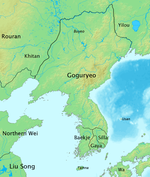
The modern spelling of Korea first appeared in the late 17th century in the travel writings of the Dutch East India Company's Hendrick Hamel.[12]
After the division of the country into North and South Korea, the two sides used different terms to refer to Korea: Chosun or Joseon (조선) in North Korea, and Hanguk (한국) in South Korea. In 1948, North Korea adopted Democratic People's Republic of Korea (Korean: 조선민주주의인민공화국, Chosŏn Minjujuŭi Inmin Konghwaguk; ⓘ) as its official name. In the wider world, because its government controls the northern part of the Korean Peninsula, it is commonly called North Korea to distinguish it from South Korea, which is officially called the Republic of Korea in English. Both governments consider themselves to be the legitimate government of the whole of Korea.[13][14] For this reason, the people do not consider themselves as 'North Koreans' but as Koreans in the same divided country as their compatriots in the South, and foreign visitors are discouraged from using the former term.[15]
History

According to Korean mythology in 2333 BCE, the Gojoseon Kingdom was established by the god-king Dangun. Following the unification of the Three Kingdoms of Korea under Unified Silla in 668 AD, Korea was subsequently ruled by the Goryeo dynasty (918–1392) and the Joseon dynasty (1392–1897). In 1897, King Gojong proclaimed the Korean Empire, which was annexed by the Empire of Japan in 1910.[18]
From 1910 to the end of World War II in 1945, Korea was under Japanese rule. Most Koreans were peasants engaged in subsistence farming.[19] In the 1930s, Japan developed mines, hydro-electric dams, steel mills, and manufacturing plants in northern Korea and neighboring Manchuria.[20] The Korean industrial working class expanded rapidly, and many Koreans went to work in Manchuria.[21] As a result, 65% of Korea's heavy industry was located in the north, but, due to the rugged terrain, only 37% of its agriculture.[22]
Northern Korea had little exposure to modern, Western ideas.[23] One partial exception was the penetration of religion. Since the arrival of missionaries in the late nineteenth century, the northwest of Korea, and Pyongyang in particular, had been a stronghold of Christianity.[24] As a result, Pyongyang was called the "Jerusalem of the East".[25]
A Korean guerrilla movement emerged in the mountainous interior and in Manchuria, harassing the Japanese imperial authorities. One of the most prominent guerrilla leaders was the Communist Kim Il Sung.[26]
Founding
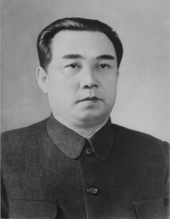
After the Japanese surrender at the end of World War II in 1945, the Korean Peninsula was divided into two zones along the 38th parallel, with the northern half of the peninsula occupied by the Soviet Union and the southern half by the United States. Negotiations on reunification failed. Soviet general Terenty Shtykov recommended the establishment of the Soviet Civil Administration in October 1945, and supported Kim Il Sung as chairman of the Provisional People's Committee of North Korea, established in February 1946. In September 1946, South Korean citizens rose up against the Allied Military Government. In April 1948, an uprising of the Jeju islanders was violently crushed. The South declared its statehood in May 1948 and two months later the ardent anti-communist Syngman Rhee[27] became its ruler. The Democratic People's Republic of Korea was established in the North on 9 September 1948. Shtykov served as the first Soviet ambassador, while Kim Il Sung became premier.
Soviet forces withdrew from the North in 1948, and most American forces withdrew from the South in 1949. Ambassador Shtykov suspected Rhee was planning to invade the North and was sympathetic to Kim's goal of Korean unification under socialism. The two successfully lobbied Soviet leader Joseph Stalin to support a quick war against the South, which culminated in the outbreak of the Korean War.[28][29][30][31]
Korean War
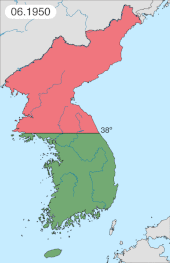
The military of North Korea invaded the South on 25 June 1950, and swiftly overran most of the country. The United Nations Command (UNC) was subsequently established following the UN Security Council's recognition of North Korean aggression against South Korea. The motion passed because the Soviet Union, a close ally of North Korea and a member of the UN Security Council, was boycotting the UN over its recognition of the Republic of China rather than the People's Republic of China.[32] The UNC, led by the United States, intervened to defend the South, and rapidly advanced into North Korea. As they neared the border with China, Chinese forces intervened on behalf of North Korea, shifting the balance of the war again. Fighting ended on 27 July 1953, with an armistice that approximately restored the original boundaries between North and South Korea, but no peace treaty was signed.[33] Approximately 3 million people died in the Korean War, with a higher proportional civilian death toll than World War II or the Vietnam War.[34][35][36][37][38] In both per capita and absolute terms, North Korea was the country most devastated by the war, which resulted in the death of an estimated 12–15% of the North Korean population (c. 10 million), "a figure close to or surpassing the proportion of Soviet citizens killed in World War II," according to Charles K. Armstrong.[39] As a result of the war, almost every substantial building in North Korea was destroyed.[40][41] Some have referred to the conflict as a civil war, with other factors involved.[42]
A heavily guarded demilitarized zone (DMZ) still divides the peninsula, and an anti-communist and anti-North Korea sentiment remains in South Korea. Since the war, the United States has maintained a strong military presence in the South which is depicted by the North Korean government as an imperialist occupation force.[43] It claims that the Korean War was caused by the United States and South Korea.[44]
Post-war developments
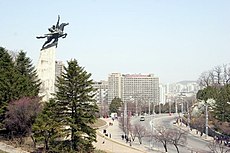
The post-war 1950s and 1960s saw an ideologicial shift in North Korea, as Kim Il Sung sought to consolidate his power. Kim Il Sung was highly critical of Soviet premier Nikita Khrushchev and his de-Stalinization policies and critiqued Khrushchev as revisionist.[45] During the 1956 August Faction Incident, Kim Il Sung successfully resisted efforts by the Soviet Union and China to depose him in favor of Soviet Koreans or the pro-Chinese Yan'an faction.[46][47] Some scholars believe that the 1956 August incident was an example of North Korea demonstrating political independence.[46][47][48] However, most scholars consider the final withdrawal of Chinese troops from North Korea in October 1958 to be the latest date when North Korea became effectively independent. In the late 1950s and early 1960s, North Korea sought to distinguish itself internationally by becoming a leader of the Non-Aligned Movement and promoting the ideology of Juche.[49] In United States policymaking, North Korea was considered among the Captive Nations.[50] Despite its efforts to break out of the Soviet and Chinese spheres of influence, North Korea remained closely aligned with both countries throughout the Cold War.[51]
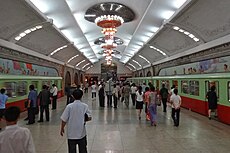
Industry was the favored sector in North Korea. Industrial production returned to pre-war levels by 1957. In 1959, relations with Japan had improved somewhat, and North Korea began allowing the repatriation of Japanese citizens in the country. The same year, North Korea revalued the North Korean won, which held greater value than its South Korean counterpart. Until the 1960s, economic growth was higher than in South Korea, and North Korean GDP per capita was equal to that of its southern neighbor as late as 1976.[52] However, by the 1980s, the economy had begun to stagnate; it started its long decline in 1987 and almost completely collapsed after the dissolution of the Soviet Union in 1991, when all Soviet aid was suddenly halted.[53]
An internal CIA study acknowledged various achievements of the North Korean government post-war: compassionate care for war orphans and children in general, a radical improvement in the status of women, free housing, free healthcare, and health statistics particularly in life expectancy and infant mortality that were comparable to even the most advanced nations up until the North Korean famine.[54] Life expectancy in the North was 72 before the famine which was only marginally lower than in the South.[55] The country once boasted a comparatively developed healthcare system; pre-famine North Korea had a network of nearly 45,000 family practitioners with some 800 hospitals and 1,000 clinics.[56]
The relative peace between the North and South following the armistice was interrupted by border skirmishes, celebrity abductions, and assassination attempts. The North failed in several assassination attempts on South Korean leaders, such as in 1968, 1974, and the Rangoon bombing in 1983; tunnels were found under the DMZ and tensions flared over the axe murder incident at Panmunjom in 1976.[57] For almost two decades after the war, the two states did not seek to negotiate with one another. In 1971, secret, high-level contacts began to be conducted culminating in the 1972 July 4 South–North Joint Statement that established principles of working toward peaceful reunification. The talks ultimately failed because in 1973, South Korea declared its preference that the two Koreas should seek separate memberships in international organizations.[58]
Leadership of Kim Jong Il
The Soviet Union was dissolved on 26 December 1991, ending its aid and support to North Korea. In 1992, as Kim Il Sung's health began deteriorating, his son Kim Jong Il slowly began taking over various state tasks. Kim Il Sung died of a heart attack in 1994; Kim Jong Il declared a three-year period of national mourning, afterward officially announcing his position as the new leader.[59]
North Korea promised to halt its development of nuclear weapons under the Agreed Framework, negotiated with U.S. president Bill Clinton and signed in 1994. Building on Nordpolitik, South Korea began to engage with the North as part of its Sunshine Policy.[60][61] Kim Jong Il instituted a policy called Songun, or "military first".[62]
Flooding in the mid-1990s exacerbated the economic crisis, severely damaging crops and infrastructure and leading to widespread famine that the government proved incapable of curtailing, resulting in the deaths of between 240,000 and 420,000 people. In 1996, the government accepted UN food aid.[63]
The international environment changed once George W. Bush became U.S. President in 2001. His administration rejected South Korea's Sunshine Policy and the Agreed Framework. Bush included North Korea in his axis of evil in his 2002 State of the Union Address. The U.S. government accordingly treated North Korea as a rogue state, while North Korea redoubled its efforts to acquire nuclear weapons.[64][65][66] On 9 October 2006, North Korea announced it had conducted its first nuclear weapons test.[67][68]

U.S. President Barack Obama adopted a policy of "strategic patience", resisting making deals with North Korea.[69] Tensions with South Korea and the United States increased in 2010 with the sinking of the South Korean warship Cheonan[70] and North Korea's shelling of Yeonpyeong Island.[71][72]
Leadership of Kim Jong Un
On 17 December 2011, Kim Jong Il died from a heart attack. His youngest son Kim Jong Un was announced as his successor.[73] In the face of international condemnation, North Korea continued to develop its nuclear arsenal, possibly including a hydrogen bomb and a missile capable of reaching the United States.[74]
Throughout 2017, following Donald Trump's ascension to the US presidency, tensions between the United States and North Korea increased, and there was heightened rhetoric between the two, with Trump threatening "fire and fury" if North Korea ever attacked U.S. territory[75] amid North Korean threats to test missiles that would land near Guam.[76] The tensions substantially decreased in 2018, and a détente developed.[77] A series of summits took place between Kim Jong Un of North Korea, President Moon Jae-in of South Korea, and President Trump.[78]
On 10 January 2021, Kim Jong Un was formally elected as the General Secretary in 8th Congress of the Workers' Party of Korea, a title previously held by Kim Jong Il.[79] On 24 March 2022, North Korea conducted a successful ICBM test launch for the first time since the 2017 crisis.[80] In September 2022, North Korea passed a law that declared itself a nuclear state.[81]
On December 30, 2023, North Korean leader Kim Jong-un provocatively declared South Korea a 'colonial vassal state,'[82] marking a significant departure from the longstanding position of mutual claims over the entire Korean Peninsula by both North and South Korea. This statement was followed by a call on January 15, 2024, for a constitutional amendment to redefine the boundary with South Korea as the 'Southern National Borderline,' further intensifying the rhetoric against South Korea. Kim Jong-un also stated that in the event of a war, North Korea would seek to annex the entirety of South Korea.[83]
Geography

North Korea occupies the northern portion of the Korean Peninsula, lying between latitudes 37° and 43°N, and longitudes 124° and 131°E. It covers an area of 120,540 square kilometers (46,541 sq mi).[2] To its west are the Yellow Sea and Korea Bay, and to its east lies Japan across the Sea of Japan.
Early European visitors to Korea remarked that the country resembled "a sea in a heavy gale" because of the many successive mountain ranges that crisscross the peninsula.[84] Some 80 percent of North Korea is composed of mountains and uplands, separated by deep and narrow valleys. All of the Korean Peninsula's mountains with elevations of 2,000 meters (6,600 ft) or more are located in North Korea. The highest point in North Korea is Paektu Mountain, a volcanic mountain with an elevation of 2,744 meters (9,003 ft) above sea level.[84] Considered a sacred place by North Koreans, Mount Paektu holds significance in Korean culture and has been incorporated in the elaborate folklore and personality cult around the Kim family.[85] For example, the song, "We Will Go To Mount Paektu" sings in praise of Kim Jong Un and describes a symbolic trek to the mountain. Other prominent ranges are the Hamgyong Range in the extreme northeast and the Rangrim Mountains, which are located in the north-central part of North Korea. Mount Kumgang in the Taebaek Range, which extends into South Korea, is famous for its scenic beauty.[84]
The coastal plains are wide in the west and discontinuous in the east. A great majority of the population lives in the plains and lowlands. According to a United Nations Environmental Programme report in 2003, forest covers over 70 percent of the country, mostly on steep slopes.[86] North Korea had a 2019 Forest Landscape Integrity Index mean score of 8.02/10, ranking it 28th globally out of 172 countries.[87] The longest river is the Amnok (Yalu) River which flows for 790 kilometers (491 mi).[88] The country contains three terrestrial ecoregions: Central Korean deciduous forests, Changbai Mountains mixed forests, and Manchurian mixed forests.[89]
Climate
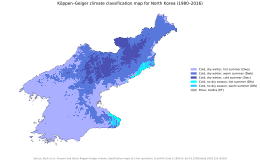
North Korea experiences a humid continental climate within the Köppen climate classification scheme. Winters bring clear weather interspersed with snow storms as a result of northern and northwestern winds that blow from Siberia.[90] Summer tends to be by far the hottest, most humid, and rainiest time of year because of the southern and southeastern monsoon winds that carry moist air from the Pacific Ocean. Approximately 60 percent of all precipitation occurs from June to September.[90] Spring and autumn are transitional seasons between summer and winter. The daily average high and low temperatures for Pyongyang are −3 and −13 °C (27 and 9 °F) in January and 29 and 20 °C (84 and 68 °F) in August.[90]
Administrative divisions
| Map | Name | Chosŏn'gŭl | Administrative seat | ||
|---|---|---|---|---|---|
| Directly-governed city (chikhalsi) | |||||
| 1 | Pyongyang | 평양직할시 | (Chung-guyok) | ||
| Special-level city (teukgeupsi) | |||||
| 2 | Kaesong | 개성특별시 | Kaesong | ||
| Special cities (teukbyeolsi) | |||||
| 3 | Rason | 라선특별시 | (Rajin-guyok) | ||
| 4 | Nampo | 남포특별시 | (Waudo-guyok) | ||
| Provinces (do) | |||||
| 5 | South Pyongan | 평안남도 | Pyongsong | ||
| 6 | North Pyongan | 평안북도 | Sinuiju | ||
| 7 | Chagang | 자강도 | Kanggye | ||
| 8 | South Hwanghae | 황해남도 | Haeju | ||
| 9 | North Hwanghae | 황해북도 | Sariwon | ||
| 10 | Kangwon | 강원도 | Wonsan | ||
| 11 | South Hamgyong | 함경남도 | Hamhung | ||
| 12 | North Hamgyong | 함경북도 | Chongjin | ||
| 13 | Ryanggang | 량강도 | Hyesan | ||
| Rank | Name | Administrative division | Pop. | Rank | Name | Administrative division | Pop. | ||
|---|---|---|---|---|---|---|---|---|---|
 Pyongyang  Hamhung |
1 | Pyongyang | Pyongyang Capital City | 3,255,288 | 11 | Sunchon | South Pyongan | 297,317 |  Chongjin  Nampo |
| 2 | Hamhung | South Hamgyong | 768,551 | 12 | Pyongsong | South Pyongan | 284,386 | ||
| 3 | Chongjin | North Hamgyong | 667,929 | 13 | Haeju | South Hwanghae | 273,300 | ||
| 4 | Nampo | South Pyongan Province | 366,815 | 14 | Kanggye | Chagang | 251,971 | ||
| 5 | Wonsan | Kangwon | 363,127 | 15 | Anju | South Pyongan | 240,117 | ||
| 6 | Sinuiju | North Pyongan | 359,341 | 16 | Tokchon | South Pyongan | 237,133 | ||
| 7 | Tanchon | South Hamgyong | 345,875 | 17 | Kimchaek | North Hamgyong | 207,299 | ||
| 8 | Kaechon | South Pyongan | 319,554 | 18 | Rason | Rason Special Economic Zone | 196,954 | ||
| 9 | Kaesong | North Hwanghae | 308,440 | 19 | Kusong | North Pyongan | 196,515 | ||
| 10 | Sariwon | North Hwanghae | 307,764 | 20 | Hyesan | Ryanggang | 192,680 | ||
Government and politics
North Korea functions as a highly centralized, one-party totalitarian dictatorship.[91][92][93][94] According to its constitution, it is a self-described revolutionary and socialist state "guided in its building and activities only by great Kimilsungism–Kimjongilism".[95] In addition to the constitution, North Korea is governed by the Ten Principles for the Establishment of a Monolithic Ideological System (also known as the "Ten Principles of the One-Ideology System") which establishes standards for governance and a guide for the behaviors of North Koreans.[96] The Workers' Party of Korea (WPK), a communist party led by a member of the Kim family,[97][98] has an estimated 6.5 million members[99] and is in control of North Korean politics. It has two satellite parties, the Korean Social Democratic Party and the Chondoist Chongu Party.[100]
Kim Jong Un of the Kim family is the current Supreme Leader or Suryeong of North Korea.[101] He heads all major governing structures: he is the general secretary of the Workers' Party of Korea and president of the State Affairs.[102][103] His grandfather Kim Il Sung, the founder and leader of North Korea until his death in 1994, is the country's "eternal President",[104] while his father Kim Jong Il who succeeded Kim Il Sung as the leader was announced "Eternal General Secretary" and "Eternal Chairman of the National Defence Commission" after his death in 2011.[102]
According to the constitution, there are officially three main branches of government. The first of these is the State Affairs Commission (SAC), which acts as "the supreme national guidance organ of state sovereignty".[105][106] Its role is to deliberate and decide the work on defense building of the State, including major policies of the State, and to carry out the directions of the president of the commission, Kim Jong Un.[107] The SAC also directly supervises the Ministry of Defence, Ministry of State Security and the Ministry of Social Security.[107]

Legislative power is held by the unicameral Supreme People's Assembly (SPA).[108] Its 687 members are elected every five years by universal suffrage,[109] though the elections have been described by outside observers as similar to elections in the Soviet Union.[110][111] Elections in North Korea have also been described as a form of government census, due to the near 100% turnout. Although the elections are not pluralistic, North Korean state media describes the elections as "an expression of the absolute support and trust of all voters in the DPRK government".[112][113] Supreme People's Assembly sessions are convened by the SPA Standing Committee, whose Chairman (Choe Ryong-hae since 2019) is the third-ranking official in North Korea.[114] Deputies formally elect the chairman, the vice chairpersons and members of the Standing Committee and take part in the constitutionally appointed activities of the legislature: pass laws, establish domestic and foreign policies, appoint members of the cabinet, review and approve the state economic plan, among others.[115] The SPA itself cannot initiate any legislation independently of party or state organs. It is unknown whether it has ever criticized or amended bills placed before it, and the elections are based around a single list of WPK-approved candidates who stand without opposition.[116]
Executive power is vested in the Cabinet of North Korea, which has been headed by Premier Kim Tok Hun since 14 August 2020,[117] who's officially the second-ranking official after Kim Jong Un.[114] The Premier represents the government and functions independently. His authority extends over two vice premiers, 30 ministers, two cabinet commission chairmen, the cabinet chief secretary, the president of the Central Bank, the director of the Central Bureau of Statistics and the president of the Academy of Sciences.[118]
North Korea, like its southern counterpart, claims to be the legitimate government of the entire Korean Peninsula and adjacent islands.[119] Despite its official title as the "Democratic People's Republic of Korea", some observers have described North Korea's political system as a "hereditary dictatorship".[120][121][122] It has also been described as a Stalinist dictatorship.[123][124][125][126]
Political ideology
Kimilsungism–Kimjongilism is the official ideology of North Korea and the WPK, and is the cornerstone of party works and government operations.[95] Juche, part of the larger Kimilsungism–Kimjongilism along with Songun under Kim Jong Un,[127] is viewed by the official North Korean line as an embodiment of Kim Il Sung's wisdom, an expression of his leadership, and an idea which provides "a complete answer to any question that arises in the struggle for national liberation".[128] Juche was pronounced in December 1955 in a speech called On Eliminating Dogmatism and Formalism and Establishing Juche in Ideological Work in order to emphasize a Korea-centered revolution.[128] Its core tenets are economic self-sufficiency, military self-reliance and an independent foreign policy. The roots of Juche were made up of a complex mixture of factors, including the popularity of Kim Il Sung, the conflict with pro-Soviet and pro-Chinese dissenters, and Korea's centuries-long struggle for independence.[129] Juche was introduced into the constitution in 1972.[130][131]
Juche was initially promoted as a "creative application" of Marxism–Leninism, but in the mid-1970s, it was described by state propaganda as "the only scientific thought... and most effective revolutionary theoretical structure that leads to the future of communist society". Juche eventually replaced Marxism–Leninism entirely by the 1980s,[132] and in 1992 references to the latter were omitted from the constitution.[133] The 2009 constitution dropped references to communism and elevated the Songun military first policy while explicitly confirming the position of Kim Jong Il.[134] However, the constitution retains references to socialism.[135] The WPK reasserted its commitment to communism in 2021.[136] Juche's concepts of self-reliance have evolved with time and circumstances, but still provide the groundwork for the spartan austerity, sacrifice, and discipline demanded by the party.[137] Scholar Brian Reynolds Myers views North Korea's actual ideology as a Korean ethnic nationalism similar to statism in Shōwa Japan and European fascism.[138][139][140]
Kim family

Since the founding of the nation, North Korea's supreme leadership has stayed within the Kim family, which in North Korea is referred to as the Mount Paektu Bloodline. It is a three-generation lineage descending from the country's first leader, Kim Il Sung, who developed North Korea around the Juche ideology, and stayed in power until his death.[141] Kim developed a cult of personality closely tied to the state philosophy of Juche, which was later passed on to his successors: his son Kim Jong Il in 1994 and grandson Kim Jong Un in 2011. In 2013, Clause 2 of Article 10 of the newly edited Ten Fundamental Principles of the Workers' Party of Korea stated that the party and revolution must be carried "eternally" by the "Mount Paektu Bloodline".[142]
According to New Focus International, the cult of personality, particularly surrounding Kim Il Sung, has been crucial for legitimizing the family's hereditary succession.[143] The control the North Korean government exercises over many aspects of the nation's culture is used to perpetuate the cult of personality surrounding Kim Il Sung,[144] and Kim Jong Il.[145] While visiting North Korea in 1979, journalist Bradley Martin wrote that nearly all music, art, and sculpture that he observed glorified "Great Leader" Kim Il Sung, whose personality cult was then being extended to his son, "Dear Leader" Kim Jong Il.[146]
Claims that the family has been deified are contested by B. R. Myers: "Divine powers have never been attributed to either of the two Kims. In fact, the propaganda apparatus in Pyongyang has generally been careful not to make claims that run directly counter to citizens' experience or common sense."[147] He further explains that the state propaganda painted Kim Jong Il as someone whose expertise lay in military matters and that the famine of the 1990s was partially caused by natural disasters out of Kim Jong Il's control.[148]
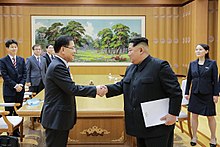
The song "No Motherland Without You", sung by the North Korean army choir, was created especially for Kim Jong Il and is one of the most popular tunes in the country. Kim Il Sung is still officially revered as the nation's "Eternal President". Several landmarks in North Korea are named for Kim Il Sung, including Kim Il Sung University, Kim Il Sung Stadium, and Kim Il Sung Square. Defectors have been quoted as saying that North Korean schools deify both father and son.[149] Kim Il Sung rejected the notion that he had created a cult around himself and accused those who suggested this of "factionalism".[150] Following the death of Kim Il Sung, North Koreans were prostrating and weeping to a bronze statue of him in an organized event;[151] similar scenes were broadcast by state television following the death of Kim Jong Il.[152]
Critics maintain that Kim Jong Il's personality cult was inherited from his father. Kim Jong Il was often the center of attention throughout ordinary life. His birthday is one of the most important public holidays in the country. On his 60th birthday (based on his official date of birth), mass celebrations occurred throughout the country.[153] Kim Jong Il's personality cult, although significant, was not as extensive as his father's. One point of view is that Kim Jong Il's cult of personality was solely out of respect for Kim Il Sung or out of fear of punishment for failure to pay homage,[154] while North Korean government sources consider it genuine hero worship.[155]
Foreign relations
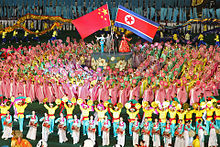
As a result of its isolation, North Korea is sometimes known as the "hermit kingdom", a term that originally referred to the isolationism in the latter part of the Joseon Dynasty.[156] Initially, North Korea had diplomatic ties only with other communist countries, and even today, most of the foreign embassies accredited to North Korea are located in Beijing rather than in Pyongyang.[157] In the 1960s and 1970s, it pursued an independent foreign policy, established relations with many developing countries, and joined the Non-Aligned Movement. In the late 1980s and the 1990s its foreign policy was thrown into turmoil with the collapse of the Soviet Bloc. Suffering an economic crisis, it closed a number of its embassies. At the same time, North Korea sought to build relations with developed free market countries.[158]
North Korea joined the United Nations in 1991 together with South Korea. North Korea is also a member of the Non-Aligned Movement, G77 and the ASEAN Regional Forum.[159] As of 2015[update], North Korea had diplomatic relations with 166 countries and embassies in 47 countries.[158] North Korea does not have diplomatic relations with Argentina, Botswana,[160] Estonia, France,[161] Iraq, Israel, Japan, Taiwan,[162] the United States,[g] and Ukraine.[163][164][165]
North Korea enjoys a close relationship with China which is often called North Korea's closest ally.[166][167] Relations were strained beginning in 2006 because of China's concerns about North Korea's nuclear program.[168] Relations improved after Xi Jinping, General Secretary of the Chinese Communist Party and Chinese President visited North Korea in April 2019.[169] North Korea continues to have strong ties with several Southeast Asian countries such as Vietnam, Laos, Cambodia,[170] and Indonesia. Relations with Malaysia were strained in 2017 by the assassination of Kim Jong-nam. North Korea has a close relationship with Russia and has supported the Russian invasion of Ukraine.[171][172]
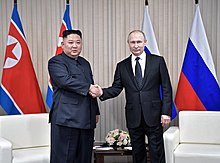
North Korea was previously designated a state sponsor of terrorism by the U.S.[173] because of its alleged involvement in the 1983 Rangoon bombing and the 1987 bombing of a South Korean airliner.[174] On 11 October 2008, the United States removed North Korea from its list of states that sponsor terrorism after Pyongyang agreed to cooperate on issues related to its nuclear program.[175] North Korea was re-designated a state sponsor of terrorism by the U.S. under the administration of Donald Trump on 20 November 2017 after continued nuclear tests.[176] The kidnapping of at least 13 Japanese citizens by North Korean agents in the 1970s and the 1980s has had a detrimental effect on North Korea's relationship with Japan.[177]
US President Trump met with Kim in Singapore on 12 June 2018. An agreement was signed between the two countries endorsing the 2017 Panmunjom Declaration signed by North and South Korea, pledging to work towards denuclearizing the Korean Peninsula.[178] They met in Hanoi from 27 to 28 February 2019, but failed to achieve an agreement.[179] On 30 June 2019, Trump met with Kim along with South Korean president Moon Jae-in at the Korean DMZ.[180]
Inter-Korean relations

The Korean Demilitarized Zone with South Korea remains the most heavily fortified border in the world.[181][182] Inter-Korean relations are at the core of North Korean diplomacy and have seen numerous shifts in the last few decades. North Korea's policy is to seek reunification without what it sees as outside interference, through a federal structure retaining each side's leadership and systems. In 1972, the two Koreas agreed in principle to achieve reunification through peaceful means and without foreign interference.[183] On 10 October 1980, the then North Korean leader Kim Il Sung proposed a federation between North and South Korea named the Democratic Federal Republic of Korea in which the respective political systems would initially remain.[184] However, relations remained cool well until the early 1990s, with a brief period in the early 1980s when North Korea offered to provide flood relief to its southern neighbor.[185] Although the offer was initially welcomed, talks over how to deliver the relief goods broke down and none of the promised aid ever crossed the border.[186] The two countries also organized a reunion of 92 separated families.[187]
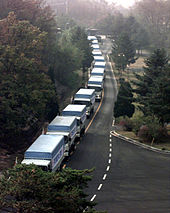
The Sunshine Policy instituted by South Korean president Kim Dae-jung in 1998 was a watershed in inter-Korean relations. It encouraged other countries to engage with the North, which allowed Pyongyang to normalize relations with a number of European Union states and contributed to the establishment of joint North-South economic projects. The culmination of the Sunshine Policy was the 2000 inter-Korean summit, when Kim Dae-jung visited Kim Jong Il in Pyongyang.[188] Both North and South Korea signed the June 15th North–South Joint Declaration, in which both sides promised to seek peaceful reunification.[189] On 4 October 2007, South Korean president Roh Moo-hyun and Kim Jong Il signed an eight-point peace agreement.[190] However, relations worsened when South Korean president Lee Myung-bak adopted a more hard-line approach and suspended aid deliveries pending the de-nuclearization of the North. In 2009, North Korea responded by ending all of its previous agreements with the South.[191] It deployed additional ballistic missiles[192] and placed its military on full combat alert after South Korea, Japan and the United States threatened to intercept a Unha-2 space launch vehicle.[193] The next few years witnessed a string of hostilities, including the alleged North Korean involvement in the sinking of South Korean warship Cheonan,[70] mutual ending of diplomatic ties,[194] a North Korean artillery attack on Yeonpyeong Island,[195] and growing international concern over North Korea's nuclear program.[196]
In May 2017, Moon Jae-in was elected president of South Korea with a promise to return to the Sunshine Policy.[197] In February 2018, a détente developed at the Winter Olympics held in South Korea.[77] In April, South Korean president Moon Jae-in and Kim Jong Un met at the DMZ, and, in the Panmunjom Declaration, pledged to work for peace and nuclear disarmament.[198] In September, at a joint news conference in Pyongyang, Moon and Kim agreed upon turning the Korean Peninsula into a "land of peace without nuclear weapons and nuclear threats".[199]
In January 2024, North Korea officially announced through its leader Kim Jong Un that it would no longer seek reunification with South Korea. Kim instead called for "completely occupying, subjugating and reclaiming" South Korea if war breaks out.[200] Kim Jong Un also announced to the Supreme People's Assembly that the constitution should be changed such that South Korea would be considered the "primary foe and invariable principal enemy" of North Korea.[201] Additionally, government agencies tasked with promoting reunification were closed.[202]
Law enforcement and internal security
Zdroj:https://en.wikipedia.org?pojem=North_KoreaText je dostupný za podmienok Creative Commons Attribution/Share-Alike License 3.0 Unported; prípadne za ďalších podmienok. Podrobnejšie informácie nájdete na stránke Podmienky použitia.
Antropológia
Aplikované vedy
Bibliometria
Dejiny vedy
Encyklopédie
Filozofia vedy
Forenzné vedy
Humanitné vedy
Knižničná veda
Kryogenika
Kryptológia
Kulturológia
Literárna veda
Medzidisciplinárne oblasti
Metódy kvantitatívnej analýzy
Metavedy
Metodika
Text je dostupný za podmienok Creative
Commons Attribution/Share-Alike License 3.0 Unported; prípadne za ďalších
podmienok.
Podrobnejšie informácie nájdete na stránke Podmienky
použitia.
www.astronomia.sk | www.biologia.sk | www.botanika.sk | www.dejiny.sk | www.economy.sk | www.elektrotechnika.sk | www.estetika.sk | www.farmakologia.sk | www.filozofia.sk | Fyzika | www.futurologia.sk | www.genetika.sk | www.chemia.sk | www.lingvistika.sk | www.politologia.sk | www.psychologia.sk | www.sexuologia.sk | www.sociologia.sk | www.veda.sk I www.zoologia.sk






